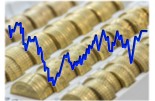Fidelity: Oil vs gold - two sides of the reopening trade

This week’s Chart Room looks at the recent pullback in gold prices and rebound in oil prices. The inverse correlation between the two suggests that investors are playing two sides of the same trade, sizing up the prospects for a reopening of the global economy and the lifting of travel restrictions on the back of groundbreaking Covid-19 vaccines.
Oil and gold are the Jekyll and Hyde of financial markets; historically, one twists while the other turns. Oil tends to perform well in risk-on environments with strong economic demand for goods and services. Gold by contrast can play an opposite role as a hedge during risk-off times, as well as a store of value when inflation is running high.
Enter 2020, when the economic fallout during the early days of the global pandemic stretched the inverse relationship between oil and gold prices to new extremes. Unprecedented monetary stimulus was unleashed as global travel ground to a standstill, and gold prices surged while oil prices slumped. Previous cases where the gold-to-oil price ratio spiked upwards include the 2008 Global Financial Crisis, and a period in 2014-2015 when Saudi Arabia unexpectedly increased oil production causing its price to crash.
But more recently, we think the near-term outlook for oil is becoming more constructive. The development of vaccines for Covid-19 and the resulting utilisation of spare economic capacity could help oil demand recover to near pre-pandemic levels. Meanwhile, supply is likely to be constrained by a lack of capital investments in production in the US and Europe. As a result, we think the oil market could tighten in the second half of 2021, putting further upward pressure on prices.
Gold, on the other hand, has been on a massive run this year, helped by expectations of low-for-longer interest rates - but the drivers for further gains appear to be on the wane. With the prospect of a rebound in global demand for travel and cross-border trade, it is difficult to see meaningful downside to real yields from here.
Meanwhile, with fiscal balance sheets stretched as they are globally, it’s unlikely economic growth will be robust enough to drive nominal yields to pre-Covid levels and there is a continuing question mark around the Fed’s ability to drive inflation to levels not seen in the recent past. These factors diminish the immediate allure of gold’s perceived value as an inflation hedge.
Although our base case for gold is still higher for longer, and bottom-up alpha opportunities still exist within the gold space, we think the gold-to-oil ratio probably has further to fall next year as the reopening trade gets underway.










